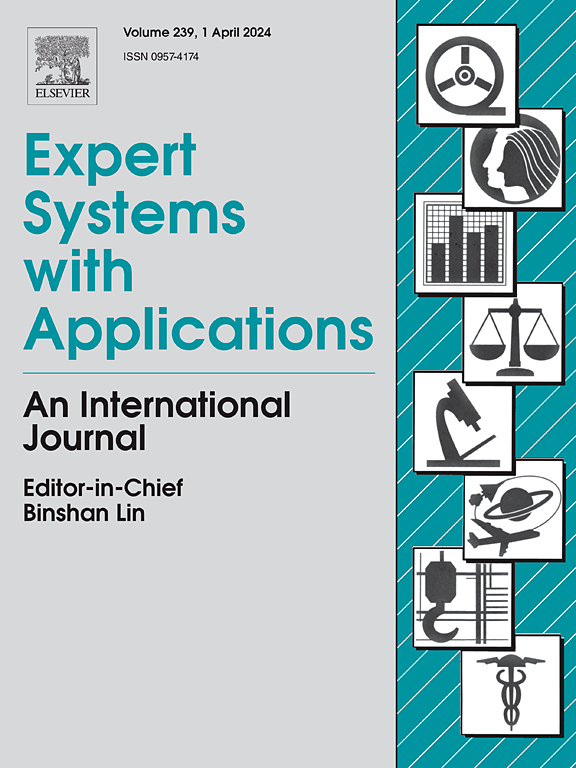ATSDPC:基于分散系数的混合距离自适应两阶段密度峰聚类
IF 7.5
1区 计算机科学
Q1 COMPUTER SCIENCE, ARTIFICIAL INTELLIGENCE
引用次数: 0
摘要
密度峰聚类(DPC)是一种简单有效的聚类算法。然而,DPC的性能受到树状分配策略引起的连锁反应的极大影响。为了克服这一问题,本文提出了一种基于分散系数的混合距离自适应两阶段密度峰聚类算法(ATSDPC)。首先,利用色散系数加权欧几里得距离,将欧几里得距离替换为色散距离。色散距离优于欧氏距离,因为色散系数可以反映不同属性对聚类性能的重要程度(贡献)。然后,提出局部距离和全局距离相结合的混合距离,利用重叠系数自适应调节,通过减少链式反应引起的错配目标数来克服链式反应。最后,采用两阶段分配策略对DPC的分配策略进行改进。在阶段1中,初始聚类结果是用色散距离而不是欧氏距离来获得的。在阶段2中,使用可调混合距离对阶段1得到的聚类结果作为输入进行迭代优化,直到重叠系数趋于稳定。在合成和真实世界数据集上的实验结果表明,ATSDPC优于最先进的基线。ATSDPC可以在不破坏任意簇形检测能力的前提下,通过减少由链式反应引起的错配对象数量来克服链式反应。ATSDPC项目将在https://github.com/Hankbet/ATSDPC上提供。本文章由计算机程序翻译,如有差异,请以英文原文为准。

ATSDPC: Adaptive two-stage density peaks clustering with hybrid distance based on dispersion coefficient
Density peaks clustering (DPC) is a simple and effective clustering algorithm. However, the performance of DPC is greatly impacted by the chain reaction caused by its tree-liked allocation strategy. To overcome this issue, this study proposes an adaptive two-stage density peaks clustering algorithm with hybrid distance based on dispersion coefficient (ATSDPC). First, the Euclidean distance is replaced by the dispersion distance by the dispersion coefficient weighting the Euclidean distance. The dispersion distance outperforms the Euclidean distance because the dispersion coefficient can reflect the importances (contributions) of different attributes for (to) the clustering performance. Then, the hybrid distance combined of local and global distances, that can adaptively adjust by employing the overlapping coefficient, is proposed to overcome chain reaction by reducing the number of misallocated objects caused by chain reaction. Finally, the allocation strategy of DPC is improved by two-stage allocation strategy. In Stage 1, the initial clustering results are obtained with the dispersion distance instead of the Euclidean distance. In Stage 2, the clustering results obtained by Stage 1 as inputs are iteratively optimized by using the adjustable hybrid distance until the overlapping coefficient stabilize. Experimental results on synthetic and real world datasets demonstrate the superiority of ATSDPC over state-of-the-art baselines. ATSDPC can overcome chain reaction by reducing the number of misallocated objects caused by chain reaction with no destruction of the ability of detecting arbitrary cluster shapes. The project of ATSDPC will be available at https://github.com/Hankbet/ATSDPC.
求助全文
通过发布文献求助,成功后即可免费获取论文全文。
去求助
来源期刊

Expert Systems with Applications
工程技术-工程:电子与电气
CiteScore
13.80
自引率
10.60%
发文量
2045
审稿时长
8.7 months
期刊介绍:
Expert Systems With Applications is an international journal dedicated to the exchange of information on expert and intelligent systems used globally in industry, government, and universities. The journal emphasizes original papers covering the design, development, testing, implementation, and management of these systems, offering practical guidelines. It spans various sectors such as finance, engineering, marketing, law, project management, information management, medicine, and more. The journal also welcomes papers on multi-agent systems, knowledge management, neural networks, knowledge discovery, data mining, and other related areas, excluding applications to military/defense systems.
 求助内容:
求助内容: 应助结果提醒方式:
应助结果提醒方式:


